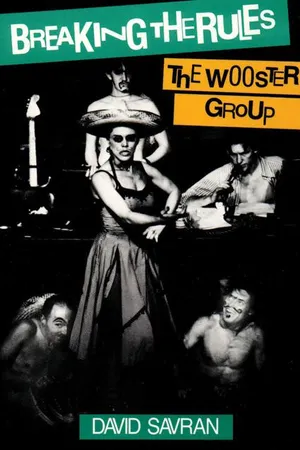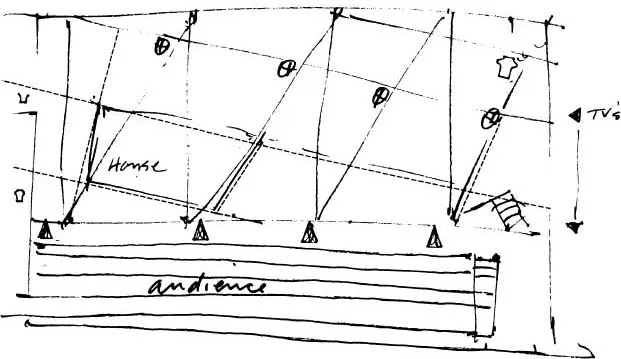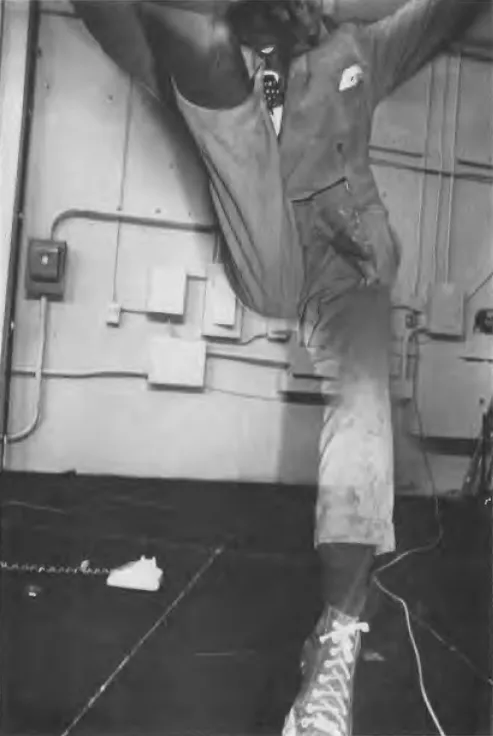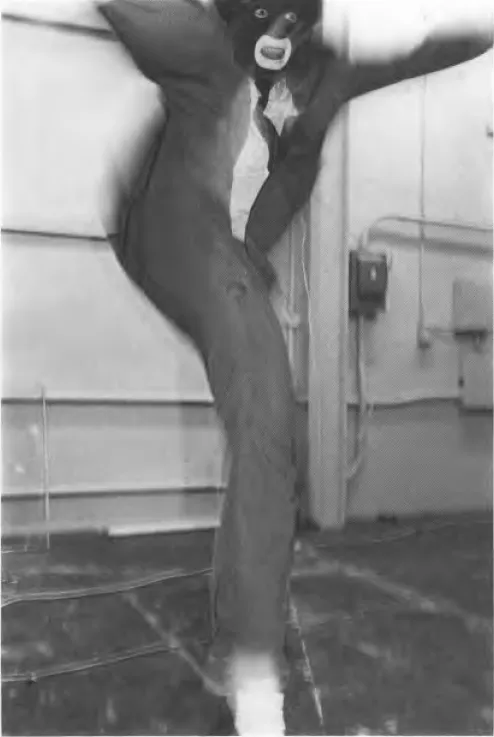
- 240 pages
- English
- ePUB (mobile friendly)
- Available on iOS & Android
eBook - ePub
About this book
Through interviews and descriptions of methodology, Breaking the Rules captures the essence of major works by the internationally acclaimed avant-garde company.
Frequently asked questions
Yes, you can cancel anytime from the Subscription tab in your account settings on the Perlego website. Your subscription will stay active until the end of your current billing period. Learn how to cancel your subscription.
At the moment all of our mobile-responsive ePub books are available to download via the app. Most of our PDFs are also available to download and we're working on making the final remaining ones downloadable now. Learn more here.
Perlego offers two plans: Essential and Complete
- Essential is ideal for learners and professionals who enjoy exploring a wide range of subjects. Access the Essential Library with 800,000+ trusted titles and best-sellers across business, personal growth, and the humanities. Includes unlimited reading time and Standard Read Aloud voice.
- Complete: Perfect for advanced learners and researchers needing full, unrestricted access. Unlock 1.4M+ books across hundreds of subjects, including academic and specialized titles. The Complete Plan also includes advanced features like Premium Read Aloud and Research Assistant.
We are an online textbook subscription service, where you can get access to an entire online library for less than the price of a single book per month. With over 1 million books across 1000+ topics, we’ve got you covered! Learn more here.
Look out for the read-aloud symbol on your next book to see if you can listen to it. The read-aloud tool reads text aloud for you, highlighting the text as it is being read. You can pause it, speed it up and slow it down. Learn more here.
Yes! You can use the Perlego app on both iOS or Android devices to read anytime, anywhere — even offline. Perfect for commutes or when you’re on the go.
Please note we cannot support devices running on iOS 13 and Android 7 or earlier. Learn more about using the app.
Please note we cannot support devices running on iOS 13 and Android 7 or earlier. Learn more about using the app.
Yes, you can access Breaking the Rules by David Savran in PDF and/or ePUB format, as well as other popular books in Media & Performing Arts & Theatre Direction & Production. We have over one million books available in our catalogue for you to explore.
Information
Part I
Route 1 & 9 (The Last Act): The Disintegration of Our Town
Our Town:
(no inflection) “Your mother’ll be coming downstairs to make believe, uh, make breakfast.”
“Chew that bacon good and slow. It’ll help keep you warm on a cold day.”
“. . . his appendix burst on a hunting trip in North Conway.”
“There are the stars making the crisscross . . .”
“This is the worst piece of shit.” “Shut up, I like it, it reminds me of Carousel.”
(Lizzie: incredible innocence & the hokey philosopher profound dimensions in downhome and he’s an asshole)
Nayatt School Notebook October 11, 1977
Elizabeth LeCompte: We began doing Our Town as a reading, fitting people into parts, rehearsing it during the day and performing it at night. Just as a reading, but excluding the part of the Stage Manager, that voice that connects, so that it would stand as a number of scenes, placed next to each other.
Kate Valk: When we started working on Route 1 & 9, it was just Our Town, reading Our Town, and I was still stage managing. Then I transcribed the Pigmeat Markham records, trying to figure out what they were saying. By the time I finished I could imitate . . . I could do all the voices. And that’s how I got started performing in Route 1 & 9, with the blackface routines.
Peyton Smith: The beginning of rehearsals was wonderful because the live performance part was dancing. And many of the early rehearsals, before we got into any depth, were spent making this wonderful musical piece that was a lot of fun to do. Of course, then it became more problematic, when we started realizing the intent, and how far it went.
***
When Route 1 & 9 (The Last Act) opened at the Performing Garage in October 1981, it polarized its audience more radically than any piece performed in New York in at least a decade. By January 1982 it had become the subject of a widely reported controversy. The dispute centered around the piece’s juxtaposition of Thornton Wilder’s Our Town against a reconstruction of a Pigmeat Markham comedy routine, performed by four actors in blackface. The New York State Council on the Arts (NYSCA), which has been a major source of funding for the Group, judged that “Route 1 & 9 contained in its blackface sequences harsh and caricatured portrayals of a racial minority”1 and, as a consequence, cut funding for the Group by forty percent, the fraction of the grant they believed subsidized the piece. The Wooster Group convened a number of public forums to discuss the piece’s alleged racism and in March submitted an appeal to NYSCA, drawn up by Jeffrey M. Jones, aimed at restoring the funding. The appeal contained a thirty-one-page defense of Route 1 & 9 as well as twenty-three letters of support by a formidable collection of artists, critics and producers. On June 10, 1982, NYSCA rejected the appeal and upheld the reduced level of funding.
***
Schema of Route 1 & 9 (The Last Act)
| Part IA | THE LESSON (Upstairs): In Which A Man Delivers a Lecture on the Structure and Meaning of Our Town |
Video reconstruction of “teaching film” | |
| Part IB | THE LESSON (Downstairs): In Which the Stage Hands Arrange the Stage for the Last Act of Our Town |
“The Lesson” continues Blind building sequence begins Black out | |
| Part II | THE PARTY: In Which the Stage Hands Call It a Day and a Telegram Is Sent |
Blind building continues The “girls” make telephone calls The Party begins (reconstruction of Pigmeat Markham routine) Video excerpts from Our Town, Act II, overlap | |
| Part III | THE LAST ACT (The Cemetery Scene): In Which Four Chairs are Placed on the Stage Facing the Audience to Represent Graves |
Video excerpts from Our Town, Act III, begin The Party continues “sotto voce” Ghoul Dance | |
| Part IV | ROUTE 1 & 9: In Which a Van Picks Up Two Hitchhikers and Heads South |
Video: “Route 1 & 9” (Driving sequence) Porn |
***

Figure 1.Performance Space for Route 1 & 9 (The Last Act)
(Elizabeth LeCompte)
(Elizabeth LeCompte)
Elizabeth LeCompte: In the beginning I had an image of the performers in blackface. Wonderful visual thing. I thought of the blackface on them, and the lighting. And I could see, almost immediately, a kind of dance structure, going up and back, along an expanded floor grid from Point Judith. Usually, that’s one of the very first things that comes: a spatial element from the preceding piece, something I couldn’t do there, that pushed it too far, or that didn’t work, in some way. It’s as if each space is an interpolation of the last. Or a rearrangement of the last, or the space before that. The performance space had been falling more and more into a kind of parallelogram grid. I took the pattern of the house drawn on the floor from the earlier pieces, the parallelogram that it had become, and extended it over the whole space. The tin house would stand on top of the grid. And we constructed dances around that. Like on a chalk board. I knew that the audience would look down from above, onto a blackboard, that I was going to be sketching on a blackboard, so to speak. And the characters would be dancing and sketching in white on a black board.

Figure 2.Route 1 & 9, The Party
Willem Dafoe, Ron Vawter.
(Nancy Campbell)
Willem Dafoe, Ron Vawter.
(Nancy Campbell)

Ron Vawter: I knew very well that we were unsettling people’s feelings, and our own feelings, about racism: racism in ourselves, racism in everybody in the audience, black and white. And it was all about pulling the rug out from under people’s secure, liberal and righteous feelings about racism, their own and society’s. We were agents provocateurs, saboteurs, working against people’s strong feelings of righteousness.
Peyton Smith: Well, sometimes, we got really scared when things got bad. I remember this one night . . . in the beginning when we got bad reviews, we’d have maybe seven people in the audience. And Route 1 & 9 is a hard show to do for seven people. Anyway, there weren’t too many people this one night. And I went through such a horror. There was a black man in the audience. And he had his coat over his lap. And he would put his hand under his coat. We were doing the part way up front, about the punch and I thought, “He’s going to shoot us. He’s closest to Ronnie. Well, I love Ronnie but that’s the way it goes. I’m going to dive under the seating arrangement.” And I had it all blocked out in my mind. And then, of course, nothing happened. So when we went off stage, I said, “Oh my God, I had such a fear.” And everyone else saw him. So it wasn’t that I was paranoid. It was so odd that we all picked up on it, because he never did anything. He just sat there, but he had this weird look. With Route 1 & 9, all the performances were exciting. And I liked that. I liked the controversy. But sometimes it was frightening.
***
Beyond Parody (Part I)
Elizabeth LeCompte: We reconstructed a 1965 Encyclopedia Britannica teaching film starring Clifton Fadiman. For a long time, I didn’t know where it would be played, we tried many different places. Finally, I separated it out and put it at the beginning, dovetailing it into the rest of the piece. Clifton Fadiman was the “Stage Manager” of Route 1 & 9, echoing Wilder s construction in Our Town. Then you’d see Ron come back as the Stage Manager, as Clifton Fadiman had played him in the tape. Those kinds of connectors came in late.
The first part of Route 1 & 9, “The Lesson: In Which a Man Delivers a Lecture,” is a videotaped lecture on Thornton Wilder’s Our Town, delivered by Ron Vawter and screened in the upstairs space at the Performing Garage. In the Wooster Group’s version, “The Lesson” appears to be a gentle mockery of the banalities of humanistic criticism. For the duration of the tape, the camera holds long static shots of the lecturer and pans portentously as he moves back and forth between a tiny model stage and the ladder to be used in Our Town (and Route 1 & 9). It zooms in for important “truths” and underscores them by spelling out the catch phrases across the bottom of the television screen. These production devices, combined with jump cuts in the editing (most of which were present in the print from which the Wooster Group worked), suggest that a subtly critical point of view is being taken toward both the speaker and his analysis of Our Town. In Ron Vawter’s deadpan characterization, the lecturer mouths the formulas of humanistic criticism with a forced informality and playfulness that mask his authoritarian pose. He explicates the play by setting himself up as a privileged interpreter who speaks for the audience: “He [Dr. Gibbs] uses the word unconsciously, he doesn’t notice it, but we do.”2 By so articulating the spectators’ emotions (“We’ve all had that feeling”3) he establishes his community with the audience in much the same way that Wilder implicates the spectator as a citizen of Our Town.
Ron Vawter: Fadiman makes these very unwieldly and awkward illustrative gestures. Willem and I studied them very carefully, second by second. When I look at my eyes in the tape, I’m amazed at how glazed over they look. I had done unconscious listening, putting on the audio tape when I was asleep. It’s as if performing it reinduced the sleep state I was in while I was digesting it.
The apparently ironic stance of “The Lesson” suggests a critique of the universalizing tendencies and the staunchly philosophical (rather than political) pose of liberal humanism. The lecturer, in what LeCompte calls his “extremely white analysis”4 of the play, would like the spectators to believe that Our Town is first and foremost a shared spiritual experience. Adopting the first person plural pronoun, he explains that the play assures the recognition that “all our lives are part of something vast and eternal.” He asserts that it “reconciles us to life” and “helps us to understand and so accept our existence on earth.” For him, Our Town, like “the humanities in general,” propounds an unchanging set of universal characteristics and all those things that “never go out of style”—birth, growing up, marriage and death.5 Between 8:40 and 11:00, the time the lecturer allots for a performance of Our Town, the Wooster Group reverses these axioms by historicizing the theatrical experience. It lifts the veil of aestheticism that certain artists and critics use to try to shield art from the realities of history and remove it from its po...
Table of contents
- Cover
- Title Page
- Copyright
- Dedication
- Contents
- List of Figures
- Foreword
- Acknowledgments
- Introduction: Writing History
- Part I: Route 1 & 9 (The Last Act): The Disintegration of Our Town
- Part II: From the Rhode Island Trilogy to Hula: Simple Demonstrations of the Laws of Physics
- Part III: L.S.D. (. . . Just the High Points . . .): History as Hallucination
- Afterword
- Notes
- Bibliography
- Index